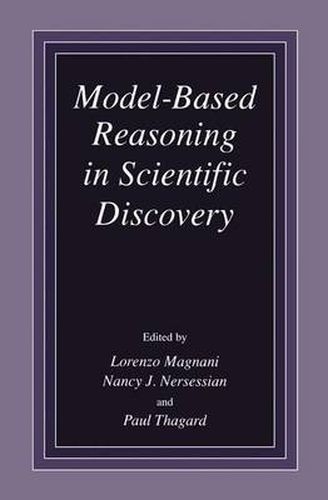Readings Newsletter
Become a Readings Member to make your shopping experience even easier.
Sign in or sign up for free!
You’re not far away from qualifying for FREE standard shipping within Australia
You’ve qualified for FREE standard shipping within Australia
The cart is loading…






This title is printed to order. This book may have been self-published. If so, we cannot guarantee the quality of the content. In the main most books will have gone through the editing process however some may not. We therefore suggest that you be aware of this before ordering this book. If in doubt check either the author or publisher’s details as we are unable to accept any returns unless they are faulty. Please contact us if you have any questions.
The volume is based on the papers that were presented at the Interna tional Conference Model-Based Reasoning in Scientific Discovery (MBR'98), held at the Collegio Ghislieri, University of Pavia, Pavia, Italy, in December 1998. The papers explore how scientific thinking uses models and explanatory reasoning to produce creative changes in theories and concepts. The study of diagnostic, visual, spatial, analogical, and temporal rea soning has demonstrated that there are many ways of performing intelligent and creative reasoning that cannot be described with the help only of tradi tional notions of reasoning such as classical logic. Traditional accounts of scientific reasoning have restricted the notion of reasoning primarily to de ductive and inductive arguments. Understanding the contribution of model ing practices to discovery and conceptual change in science requires ex panding scientific reasoning to include complex forms of creative reasoning that are not always successful and can lead to incorrect solutions. The study of these heuristic ways of reasoning is situated at the crossroads of philoso phy, artificial intelligence, cognitive psychology, and logic; that is, at the heart of cognitive science. There are several key ingredients common to the various forms of model based reasoning to be considered in this book. The models are intended as in terpretations of target physical systems, processes, phenomena, or situations. The models are retrieved or constructed on the basis of potentially satisfying salient constraints of the target domain.
$9.00 standard shipping within Australia
FREE standard shipping within Australia for orders over $100.00
Express & International shipping calculated at checkout
This title is printed to order. This book may have been self-published. If so, we cannot guarantee the quality of the content. In the main most books will have gone through the editing process however some may not. We therefore suggest that you be aware of this before ordering this book. If in doubt check either the author or publisher’s details as we are unable to accept any returns unless they are faulty. Please contact us if you have any questions.
The volume is based on the papers that were presented at the Interna tional Conference Model-Based Reasoning in Scientific Discovery (MBR'98), held at the Collegio Ghislieri, University of Pavia, Pavia, Italy, in December 1998. The papers explore how scientific thinking uses models and explanatory reasoning to produce creative changes in theories and concepts. The study of diagnostic, visual, spatial, analogical, and temporal rea soning has demonstrated that there are many ways of performing intelligent and creative reasoning that cannot be described with the help only of tradi tional notions of reasoning such as classical logic. Traditional accounts of scientific reasoning have restricted the notion of reasoning primarily to de ductive and inductive arguments. Understanding the contribution of model ing practices to discovery and conceptual change in science requires ex panding scientific reasoning to include complex forms of creative reasoning that are not always successful and can lead to incorrect solutions. The study of these heuristic ways of reasoning is situated at the crossroads of philoso phy, artificial intelligence, cognitive psychology, and logic; that is, at the heart of cognitive science. There are several key ingredients common to the various forms of model based reasoning to be considered in this book. The models are intended as in terpretations of target physical systems, processes, phenomena, or situations. The models are retrieved or constructed on the basis of potentially satisfying salient constraints of the target domain.